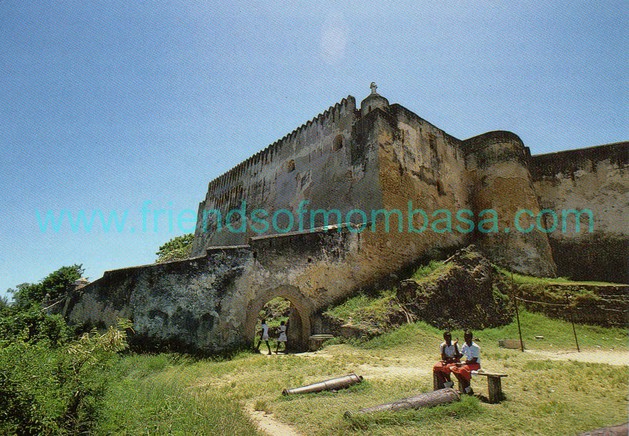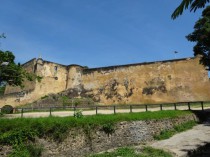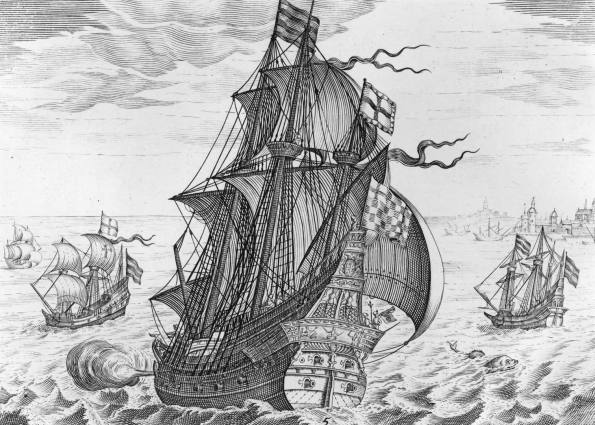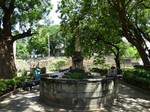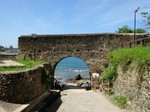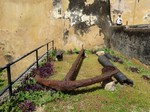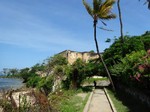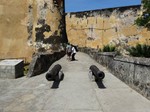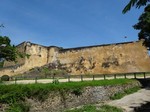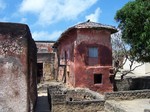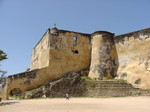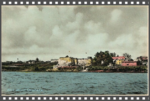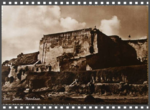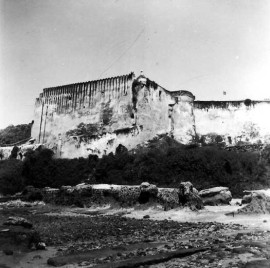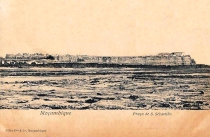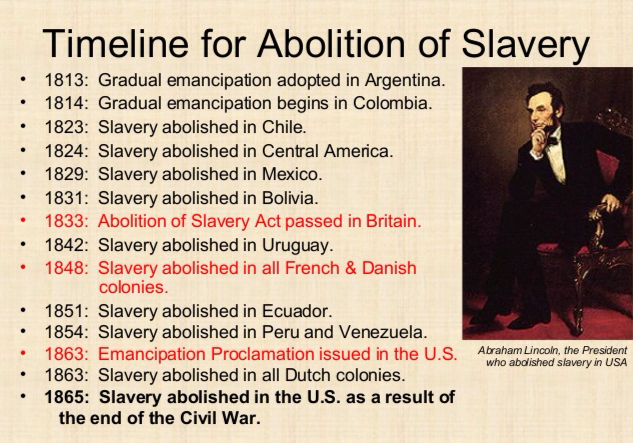FORT JESUS
The Fort, built by the Portuguese in 1593-1596 to the designs of Giovanni Battista Cairati to protect the port of Mombasa, is one of the most outstanding and well preserved examples of 16th Portuguese military fortification and a landmark in the history of this type of construction. The Fort's layout and form reflected the Renaissance ideal that perfect proportions and geometric harmony are to be found in the human body. The property covers an area of 2.36 hectares and includes the fort's moat and immediate surroundings.The Portuguese fought for and won control over coastal trading points, and they established a presence at the trading center at Sena, on the south bank of the Zambezi River. There were about 50 Portuguese and around 750 Indians in addition to racially mixed Africans. The Portuguese operated trade fairs, exchanging beads and cloth for African gold and ivory. Since Portuguese Caucasians were limited in numbers and held higher positions, their foot soldiers, most of their army and work force consisted of Indians (mostly Goans), Swahili, racially mixed Africans and Africans therefore to say it was built by 100% Portuguese cannot be totally true. Building of Fort Jesus must have had Artisans from India as well as others influence in undertaking such a big project, all this whilst also defending Mombasa and other Portuguese interests is not possible.
Its architect was Joao Batista Cairato, an Italian. He employed labour from
Mombasa’s ‘rival, Malindi and brought masons from Goa in India. In structure Fort
is basically a rectangle with four protruding bastions at the corners so constructed
that every part of the base of the Fort could be swept by defending fire from protected positions. The main entrance is
angled behind the north east bastion. At various times three subentry passages were constructed so that the Fort could be
reached via outworks from the seaward side.
David F. Horrobin
African Rivalries and Racial Diffusions on Africa's Eastern Seaboard
http://www.fsmitha.com/h3/h28af3-7.htm
Brief Description
The Fort, built by the Portuguese in 1593-1596 to the designs of Giovanni Battista Cairati to protect the port of Mombasa, is one of the most outstanding and well preserved examples of 16th
Portuguese military fortification and a landmark in the history of this type of construction. The Fort's layout and form reflected the Renaissance ideal that perfect proportions and geometric harmony are to be found in the human body. The property covers an area of 2.36 hectares and includes the fort's moat and immediate surroundings.
Brief synthesis
Built by the Portuguese at the end of the 16th century at the southern edge of the town of Mombasa, over a spur of coral rock, and kept under their control for one century, Fort Jesus, Mombasa, bears testimony to the first successful attempt by Western civilization to rule the Indian ocean trade routes, which, until then had remained under Eastern influence. The design of the fort, with its proportions, its imposing walls and five bastions, reflects the military architectural theory of the Renaissance. Fort Jesus, Mombasa, bears physical witness, in its structures and subsequent transformations, also to the interchange of cultural values and influences between and among peoples of African, Arab, Turkish, Persian and European origin that fought to gain and maintain their control over this strategic port.
Criterion (ii): Built in a period and in a region, which were at the centre of the emerging political, commercial, and cultural globalisation, Fort Jesus, with its imposing structure, and the various traces of subsequent modifications, bears significant witness to the interchange of cultural values among peoples of African, Arab, Turkish, Persian and European origin. Built and occupied first by the Portuguese, Fort Jesus, Mombasa, changed hands many times throughout its history, coming under Arab, Swahili and English control. Its important role in the control of trade also saw it host many of the peoples of the Indian Ocean basin.
Criterion (iv): Fort Jesus, Mombasa, eminently exemplifies a new type of fortification that resulted from the innovations in military and weapons technology that occurred between the 15th and 16th centuries. In its layout and form, the Fort reflects the Renaissance ideal whose architectural proportions and geometric harmony are to be found in the proportions of the human body, while at the same time meeting the functional needs of a modern and well-defended fortification. The original layout of the Fort, despite several changes, has survived almost unchanged over centuries of continued occupations and reoccupations.
Integrity
The boundaries of the property have been delineated to include the underwater archaeological remains in the expanse of sea in front of Fort Jesus as well as the moat area adjacent to Mombasa Old Town. Minor changes inside the Fort bear witness to its history and do not threaten its integrity. The property is in good conditions and there is no urban or development encroachment in its immediate vicinity. Mombasa Old Town, which is integral to Fort Jesus’ historic context, acts as the buffer zone of the Fort.
Authenticity
In regard to authenticity, Fort Jesus, Mombasa, hasretained its form, design and materials, with coral stone and lime mortar still being used in the traditional way, where necessary, for repair and conservation work. It has also retained its authenticity of setting, located on an otherwise unbuilt property along the coast of Mombasa Island adjacent to the Mombasa Old Town with which it shares a common history.
Protection and management requirements
The legal protection system for the property is adequate: Fort Jesus, Mombasa, was originally designated a National Park in 1958, the protected area included the Fort itself and a 100-meter strip around it; today it falls under the National Museums and Heritage Act, 2006. The buffer zone has been formally declared a Conservation Area, however, a discrepancy between the size of the designated Conservation Area and the size of the Buffer Zone has not been amended yet.
A satisfactory management plan has been put in place for the property with the National Museums of Kenya acting as the key stakeholder in its conservation and safeguarding.
Long-term conservation and management issues include the protection of the Fort from urban encroachment and inappropriate design in the areas adjacent to the Fort and in the surrounding Mombasa Old Town, which require the reinforcement of dedicated management structures and staff, control of erosion of the rocks along the sea coast, and the ongoing maintenance and conservation of the Fort itself.
FORT JESUS, MOMBASA, (KENYA) NOMINATION DOSSIER FOR INSCRIPTION ON THE WORLD HERITAGE LIST
http://whc.unesco.org/uploads/nominations/1295rev.pdf
Portugal and the Congo: Impact of the Slave Trade
Slave Trading
In the 1480s, Portuguese ships arrived in Central Africa at the mouth of the Congo River, the center of the Kongo kingdom. It was from the Kongo that Europeans got the name for the entire region. Initially, the Kongo were glad to trade with the Portuguese, because the relationship provided a new market for their goods and they received goods from the Portuguese. The Kongo also hoped that the Portuguese would share new technological knowledge. In a few years, however, the Portuguese traders found that the Kongo could not supply the volume of gold, copper, and other valuable resources that they wanted. After the Portuguese established sugar-cane plantations on nearby islands off the coast of central Africa, they found African labor—slaves—to be a much more valuable commodity.
Slavery existed throughout the continent of Africa before Europeans began to travel there. In Africa, slaves were often prisoners of war captured from enemies, who were either eventually ransomed back to their families or sold to others. Frequently, enslaved people were allowed to earn money or own land, or even to marry locals. Over the course of generations, enslaved Africans and their descendants were often able to assimilate into their new societies. Despite these traditions, some slaves still were abused and many desired their freedom.
How did Portuguese slave trading influence Central Africa?
When the Portuguese suggested trading merchandise for slaves, the concept among the Kongo and other peoples of the region was not new. However, the influence
of the Portuguese and their high demand for slaves changed the local African societies. Conflicts between different groups intensified as they searched for new captives who could be traded for
European manufactured goods, including weapons. The introduction of guns disrupted societies, and changed the nature of their relationships with one another. Those with direct contacts with the
Portuguese could trade humans for weapons which could then be used to capture still more slaves.
In 1506, King Afonso took the throne of the Kongo. Afonso converted to Christianity and even communicated with the Pope in Rome. He sent his son to study in
Portugal, who returned to become the first black Catholic bishop. He also increased his power and the size of his kingdom by using guns he purchased from the Portuguese.
Beginning in 1514, the slave trade became an integral part of the economy of the area. Like all Kongo monarchs, Afonso owned slaves, but he was troubled by
the nature of this new slave trade. In 1526, he wrote to the Portuguese king about its disruptive effects on his kingdom.
“Sir, Your Highness should know how our Kingdom is being lost in so many ways.... We cannot reckon how great the damage is, since the mentioned merchants are
taking every day our natives, sons of the land and the sons of our noblemen and vassals and our relatives, because the thieves and men of bad conscience grab them wishing to have the things and wares
of this Kingdom…. So great, Sir, is the corruption…that our country is being completely depopulated, and Your Highness should not agree with this nor accept it.”
—King Afonso’s letter to the King of Portugal
Afonso’s pleas had no effect. Instead, increasing numbers of Europeans—notably the French, British, and Dutch—came to the region to purchase more slaves for
their plantations in the New World. By the late eighteenth century, Europeans were exporting about fifteen thousand slaves per year from the Congo. Congolese middlemen traded with groups in the
interior to supply this demand. European records from the 1790s show slaves arriving at the coast from as far inland as seven hundred miles. Until Europeans abandoned the slave trade in the early
1800s, it dominated the commerce of the area.
Many ethnic groups in the interior abandoned their traditional productive activities such as farming and fishing to devote all of their time to the slave
trade and the trade of other European products. Records show that the Aruwimi people, over two thousand miles from the coast, received European and American cloth, satin strips, kettles, umbrellas,
brass rods, iron cooking pots, pipes, mirrors, knives, beads, muskets, and gunpowder in trade for local products. While some ethnic groups lost large numbers of their people to slavery, other groups
prospered as the middlemen of the slave trade.
The damage the slave trade caused Africa can never be fully calculated, but some statements can be made with certainty. The slave trade caused direct loss of
life through warfare, both with Europeans and among African ethnic groups. Fighting caused indirect loss of life through destruction of crops and food storage areas, and through the spread of
diseases. The slave trade enriched African kingdoms and communities that had developed advanced methods of warfare, but destroyed many smaller populations that fell victim to
conquest.
Many captives died while being transported to the coast or on the voyage overseas. The result was the loss of millions of lives. However, the Congo interior suffered far less from the slave trade than did many areas of West Africa and coastal areas of Central Africa, the main sources of slaves taken by European traders. Historians estimate that one and a half million slaves were taken out of the Congo region. Overall, the Atlantic slave trade took about twelve million people from Africa.
From: Colonialism in the Congo: Conquest, Conflict, and Commerce. Choices Program.
There is plenty of evidence out there about Indian Ocean Slave Trade and the Zeng...in fact not many know that Portuguese were along the Coast of East Africa
for 200 yrs and all that trading as well as Slave trading was the residual and doved tailed into the 1900's due to on the basis supply and demand,.. ,
In 1698, two years short of the 18th century, Zanzibar fell under the control of the Sultanate of Oman, which developed an economy of trade and cash crops, with a ruling Arab elite and a Bantu
general population.
Later on scramble for Africa: Berlin Conference of 1884-85 kicked off that had seen the emergence of more Europeans take interest in the African continent,
some along the East Coast right up to the Suez Canal.
(The Dutch India Company's "Slave Lodge at the Cape by Helene Vollgraaf for SA Cultural History Museum) also read “the British in Mombasa” by Sir John Gray 1824-1826.
Earlier, the Indian subcontinent was the main source of slaves during the early part of the 18th century, supplying about 80% of the slaves. A temporary slaving station was established in Delagoa Bay
(present day Maputo) .....
Why was declining Christianity sought so much into Africa , yet the Colonials were hardly church goers, racists, brutal, treated people of colour
different, totally acted against the teachings of the Bible , yet colonials were out to conform.
In the process Colonials made the original Olive coloured Jesus into a blue eyed white one, then drilled into them “ accordingly to the bible”
…quote….Ephesians 6:5 Slaves, obey your earthly masters with fear and trembling, with a sincere heart, as you would Christ.
: “Slaves, submit yourselves to your masters with all respect, not only to the good and gentle but also to the cruel.” (1 Peter 2:18)
Trade Act 1807, officially An Act for the Abolition of the Slave Trade,[1] was an Act of the Parliament of the United Kingdom prohibiting the slave trade in the British Empire.
Yet, Leopold II was endured by all Western nations; Leopold amassed a huge personal fortune by exploiting the natural resources of the Congo, Estimates of the death toll ranged to fifteen million,
innocent men, women and children. Leopold II (9 April 1835 – 17 December 1909), Colonization 1876–1885, Congo Free State 1885–1908, Belgian Congo 1908–1960…
Congo is being uninterruptedly raped, pillaged, and plundered like many countries in Africa, to this day by many Western Nations!
It is also evident that Slaves from East Africa were shipped to the Middle East and India, Portuguese and other Europeans were the prominent force there
during the 16th Century in the Indian Ocean region and beyond?
Read about the history of the Indian Slaves that were shipped into Africa and other places… Read Ansu Datta’s book (From Bengal to the Cape).
Today, due to lack of information, beyond rhetoric and Eurocentric propaganda, some think that the African/Arab slave trade and the European trade shared all the
same properties—that they were mirrors of the same reality. So wherever a sentence says “European slave trade” just replace it with “Arab slave trade” and you have that history. Because Christianity
in the African world (excluding Ethiopia) was largely the product of slavery and colonialism, it must also be true for Islam in Africa.
Ahain , today, as the voice of the enslaved African community asserts itself in the world and lifts up the demand for reparations, the blame-shifting “African
collaborator” argument can be seen gaining traction in universities and bourgeois historical publications, not as an historical argument but as a political defence against the legitimacy of the
reparations demand. As an organization of white people working under the leadership of the African People’s Socialist Party to organize white people in solidarity with the African struggle for
liberation and reparations, we in the Uhuru Solidarity Movement find it timely to publish this excerpt here....read further into its findings...
Just a couple of excerpts described above from different historian/editors…read much more on ..also read on the indentured labour , a form of slave trade
during the late 1800’s by the British.
Indian Slaves and Indentured labour
Nineteenth Century had seen a change in people’s perception towards living as slaves, even though Slavery Abolition Act 1833 came, that was an Act for the
Abolition of Slavery throughout the British Colonies, they were continued to be oppressed and lived like third class citizens on their own indigenous lands, in fact lives were manipulated by
colonials so that living was deliberately made difficult in some cases through hoarding and engineering exports on home grown products…
Most of the images witnessed were/are of the poor people who were Indentured labourers who were basically slaves and were tricked into signing contracts by
colonials that they could not or had no idea what the contents read. Most of those poor people and their families could never ever come back home to India ever again because they were not allowed
to.
They were shipped half way round the globe to the West Indies, Mauritius, Reunion, Madagascar, Fiji, and South Africa ..etc..to work on Sugar plantations as slaves.
In fact Ugandan Railways was actually built by Indentured labourers (a form of slave trade) from India, built around the late 1800’s up to early 1902.
Please click below on photo for further info on Slave trade:
"Mombasa by Night" - Fort Jesus
Bookings for "Mombasa by Night"
http://www.getyourguide.co.uk/mombasa-l443/evening-3-hour-dhow-cruise-and-dinner-at-fort-t4643/
Visiting Fort Jesus
Click on Photo
National Museums of Kenya (NMK) is a state corporation established by an Act of Parliament, the Museums and Heritage Act 2006. NMK is a multi-disciplinary institution whose role is to collect, preserve, study, document and present Kenya’s past and present cultural and natural heritage.
This is for the purposes of enhancing knowledge, appreciation, respect and sustainable utilization of these resources for the benefit of Kenya and the world, for now and posterity. NMK’s mutual
concern for the welfare of mankind and the conservation of the biological diversity of the East African region and that of the entire planet demands success in such efforts.
In addition, NMK manages many Regional Museums, Sites and Monuments of national and international importance alongside priceless collections of Kenya’s living cultural and natural heritage. As an
institution that must respond to the growing needs of the society, NMK is striving to contribute in a unique way to the task of national development.
Join Facebook Group on Fort Jesus: https://www.facebook.com/groups/244958412221215/
Download National Museums Heritage Act of 2006
Download National Museums of Kenya History
http://www.museums.or.ke/content/blogcategory/48/76/
Old Town and Fort Jesus
Island of Mozambique
The island was a major Arab port and boat building center in the years before Vasco da Gama visited in 1498. The name of the island (Portuguese: Moçambique, pronounced [musɐ̃ˈbiki]) is derived from Ali Musa Mbiki (Musa Al Big), sultan of the island in the times of Vasco da Gama.[1] This name was subsequently taken to the mainland country which is modern-day Mozambique, and the island was renamed Ilha de Moçambique (Island of Mozambique).
http://en.wikipedia.org/wiki/Island_of_Mozambique
http://ensina.rtp.pt/artigo/fortaleza-de-sao-sebastiao-em-mocambique/
https://delagoabayworld.wordpress.com/category/lugares/ilha-de-mocambique/
Slavery Timeline 1400-1500
A Chronology of Slavery, Abolition, and Emancipation in the Fifteenth Century
http://www.brycchancarey.com/slavery/chrono2.htm
The European Slave Trade, the destruction of Africa by Portugal
https://en.lisapoyakama.org/the-terrorism-of-european-slave-raiders-and-the-destruction-of-africa/


